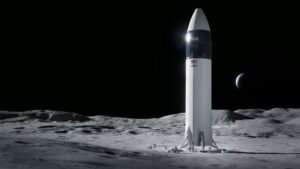NASA seeking more than $10 billion in infrastructure bill
By Jeff Foust

WASHINGTON — NASA Administrator Bill Nelson told House appropriators May 19 that the agency is requesting more than $11 billion in an upcoming infrastructure bill that would go for the agency’s Human Landing System program and upgrading center facilities.
Nelson, testifying in a virtual hearing by the House Appropriations Committee’s commerce, justice and science subcommittee about NASA’s fiscal year 2022 budget proposal, said the agency has submitted to Congress requests for funding to be included in legislation to enact what the White House calls the American Jobs Plan, which has a total value of $2.3 trillion over 10 years.
He told members that NASA was seeking $5.4 billion for the Human Landing System to fund competition for future lander missions beyond the “Option A” award the agency made to SpaceX April 16. That award covers development of a lander based on SpaceX’s Starship vehicle and a single crewed landing. NASA plans to conduct a separate solicitation for future missions, which will be open to both SpaceX and other companies.
“You, the appropriators, as a partner, you’ve got the opportunity to put over about $5 billion in the jobs bill,” he told members. “Specifically, we named about $5.4 billion on the Human Landing System.”
Several members of the subcommittee said they were concerned about NASA’s decision to make only a single Option A award after agency officials previously stated they would seek to make up to two awards. Nelson said the shortfall in funding for the HLS program, which received $850 million — a quarter its original request — in fiscal year 2021, led to the decision to select only one company. “They just simply didn’t have enough to keep going forward on more than one lander,” he said.
He declined to go into specifics about the HLS award selection process, referring to a “blackout period” as the Government Accountability Office reviews protests filed by the two losing bidders, Blue Origin and Dynetics. If the GAO sustains the protests, “then everything starts over” with the program, he said. If the GAO denies the protests, he said NASA will go forward with a competition for later landing missions.
Among the critics of the HLS award was the committee’s ranking member, Rep. Robert Aderholt (R-Ala.), who said it was “unacceptable for the fate of the U.S. access to cislunar space to be in the hands of only one company.”
Aderholt later asked if NASA could provide funding to all three companies that received HLS base period contracts in 2020 through this August. Nelson said procurement law prevented him from doing so because of the blackout period caused by the protests. He said the agency has obligated $410 million so far this fiscal year on the HLS program, but has spent no money on the Option A award to SpaceX because of the protest.
Nelson said that NASA would also request in the infrastructure bill another $5.4 billion to upgrade facilities at NASA centers. “There’s aging infrastructure that is dilapidated” at centers like the Ames Research Center and Armstrong Flight Research Center in California, he told Rep. Mike Garcia (R-Calif.)
He also cited an administration building at the Marshall Space Flight Center that needs to be demolished and the need for repairs of the Michoud Assembly Facility in New Orleans. “They’ve got holes in the roof where they’re putting together the core of the SLS,” he said. “You all can really, really help us.”
Nelson said NASA would also seek in the infrastructure bill $200 million to fund development of new spacesuits for the Artemis program and $585 million for nuclear thermal propulsion technology for later missions to Mars. “That would have not only extraordinary R&D benefits, but ultimately producing, because of the development of new technology, new things that produce new jobs,” he told Rep. Ben Cline (R-Va.), who asked about nuclear thermal propulsion work at NASA.
The funding in the infrastructure bill, which would likely be spent over several years, would be in addition to the agency’s overall budget request. The White House released an outline of its fiscal year 2022 budget proposal April 9, including $24.7 billion for NASA, a 6% increase over 2021. However, full details about the budget won’t be released until May 27.
That limited the level of detail that appropriators could ask Nelson about the budget, but many said they were pleased at least with the broad outlines of the proposal. “The president’s so-called ‘skinny’ budget sets a good tone, proposing $24.7 billion for fiscal year 2022,” said Rep. Matt Cartwright (D-Pa.), chairman of the subcommittee.
Aderholt, late in the two-hour hearing, probed Nelson for details about proposed funding for the upgraded SLS Block 1B vehicle, which uses the Exploration Upper Stage under development. “I don’t have the budget request because the president hasn’t put it out,” Nelson responded. “But, a little birdie told me that he thinks you’ll be happy with the budget request.”
May 20, 2021 at 03:13AM
via SpaceNews read more...

Post a Comment